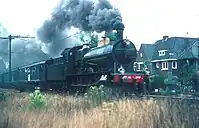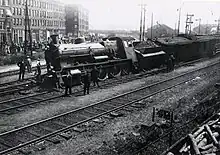NS 3700
The NS 3700 class was a class of express steam locomotives with the wheel arrangement of 2'C (4-6-0) of Nederlandse Spoorwegen (NS) and its predecessor Maatschappij tot Exploitatie van Staatsspoorwegen (SS).
| NS 3700 | |||||||||||||||||||||||||||||||||||||||||||||||||||||
|---|---|---|---|---|---|---|---|---|---|---|---|---|---|---|---|---|---|---|---|---|---|---|---|---|---|---|---|---|---|---|---|---|---|---|---|---|---|---|---|---|---|---|---|---|---|---|---|---|---|---|---|---|---|
.jpg.webp) | |||||||||||||||||||||||||||||||||||||||||||||||||||||
| |||||||||||||||||||||||||||||||||||||||||||||||||||||
| |||||||||||||||||||||||||||||||||||||||||||||||||||||
| |||||||||||||||||||||||||||||||||||||||||||||||||||||
| |||||||||||||||||||||||||||||||||||||||||||||||||||||
History



The first 109 locomotives of this series were delivered to the SS between 1910 - 1920 and numbered 685 - 778 and 785 - 799. The manufacturers were Beyer, Peacock & Company (36 engines), Werkspoor (48 engines), Hanomag (10 engines) and Henschel & Son (15 engines). After the merger of the SS and the HSM in 1921, six more locomotives were delivered by Werkspoor in that same year. The series was then given the NS numbers 3701–3815. In 1928 another order of five locomotives were ordered from Schwarzkopff and built to a slightly altered design. The whole classed was numbered between 3701 - 3820 after the last once were added to the fleet.[1]
| SS Number | NS nummers | Date | Built by | Lot No. | Additional notes |
|---|---|---|---|---|---|
| 701-706 | 3701-3706 | 1910 | Beyer, Peacock & Company | 5370-5375 | |
| 707-718 | 3707-3718 | 1911 | Beyer, Peacock & Company | 5451-5462 | |
| 731-742 | 3737-3748 | 1911 | Werkspoor | NS 3737 is preserved at the Spoorwegmuseum | |
| 743-750 | 3749-3756 | 1912 | Werkspoor | ||
| 719-730 | 3719-3730 | 1913 | Beyer, Peacock & Company | 5640-5651 | |
| 695-700 | 3731-3736 | 1913 | Beyer, Peacock & Company | 5721-5726 | |
| 751-760 | 3757-3766 | 1913/1914 | Werkspoor | ||
| 761-766 | 3767-3772 | 1915 | Werkspoor | ||
| 767-778 | 3773-3784 | 1918/1919 | Werkspoor | ||
| 785-799 | 3791-3805 | 1920 | Henschel & Son | 17744-17758 | |
| 685-694 | 3806-3815 | 1920 | Hanomag | 9343-9352 | |
| (779-784) | 3785-3790 | 1921 | Werkspoor | Ordered by the SS but entered service with the NS numbers | |
| 3816-3820 | 1928 | Schwartzkopff | 9336-9340 | Orderded by the NS and entered service with NS numbers |
The Noord-Brabantsch-Duitsche Spoorweg-Maatschappij (NBDS) was the first railway company in the Netherlands to use express locomotives with the wheel arrangement 2'C (4-6-0) in 1908 (NBDS 30–35, later NS 3500). They achieved good results with them, they asked the SS to test one of these locomotives on the line between Amsterdam and Emmerich. This test was a great success, after seeing how successful the locomotives were the SS also bought 2'C (4-6-0) express locomotives. The NBDS locomotives only had two inside cylinders, the SS opted for a locomotive with four cylinders.
The locomotives were designed by the SS, looking to British locomotive design for inspiration, for pulling (express)passenger trains. Compared to the SS series 801 - 935 (NS 1701 - 1835), the NS 3700 class had twice the amount of power, and were therefore nicknamed "Jumbo". This series quickly became important for pulling trains in the Netherlands. They had to hand over their heaviest express trains to their stronger brothers of the NS 3900 class after 1929. After they experienced problems with the new Mat'34 that was supposed to provide fast connections between the major cities, they used a locomotive of the NS 3700 class to replace them. With these so-called steam diesels services, speeds of more than 120 km/h were achieved.[2]
The locomotives of the NS 3700 class had either a three- or four-axle tender to carry the necessary amount of coal and water. In 1929 a tank engines version ("Tender jumbos") appeared with a wheel arrangement of 2'C2' (4-6-4) as the NS 6100 series.[1] Ten of these locomotives were built (five locomotives were built by Hohenzollern and the other five by Werkspoor). A lighter tank engine was previously built by Beyer, Peacock & Company with only two inside cylinders and a slightly smaller boiler, the NS 6000 series.
Locomotive 3737
Locomotive 3737, built in 1911 as SS 731 by Werkspoor, made its first test run between Amsterdam and Utrecht on 28 August 1911. She officially entered service on the 11th of September 1911. Locomotive 3737 (allocated to Roosendaal shed) ran the last official NS steam hauled service from Geldermalsen to Utrecht Maliebaan on the 7th of January 1958, where the Spoorwegmuseum was already located at that time. The locomotive 3737 was subsequently included in the collection of the museum.[3]
In the 1970s, the NS 3737 was overhauled to be used for special rail tours. In the 1974 and '75 steam seasons, the locomotive was leased to the Stichting Stoomtrein Tilburg-Turnhout (SSTT), which operated a tourist train service on a stretch of the Tilburg - Turnhout railway line. The NS 3737 played an important role in the anniversary celebration of 150 years of Railways in the Netherlands in 1989. In the years that followed, the locomotive, has occasionally been active on the railway network. In 1996 she got a completely new boiler with a new firebox. The intention was to use the locomotive on a regular basis, but it broke down after a few runs. When an overhaul was needed in 2008, the Railway Museum announced that it wanted to use part of a subsidy received from the BankGiro Lottery for this, but at the end of 2008 the amount turned out to be insufficient.[3]
Gallery
- Test run with the streamlined NS 3801. (1936)
 Locomotive NS 3759 at the reopening of the railway bridge in Buggenum on the 29th of September 1947.
Locomotive NS 3759 at the reopening of the railway bridge in Buggenum on the 29th of September 1947. NS locomotive 3752 with freight train on the 'bathtub railway' through the Kruiningerpolder after the flood of 1953; 11 June 1953.
NS locomotive 3752 with freight train on the 'bathtub railway' through the Kruiningerpolder after the flood of 1953; 11 June 1953. NS locomotive 3704 in the flooded Kruiningerpolder; 11 June 1953.
NS locomotive 3704 in the flooded Kruiningerpolder; 11 June 1953. Locomotive NS 3819 at the flooded Kruiningerpolder; 11 June 1953.
Locomotive NS 3819 at the flooded Kruiningerpolder; 11 June 1953. Locomotive NS 3760 in Amersfoort. (1953)
Locomotive NS 3760 in Amersfoort. (1953)- The NS 3737 running in preservation. (1974) (Spoken in Dutch)
 Locomotive NS 3737 on May 23, 1974, with an excursion train in Bilthoven.
Locomotive NS 3737 on May 23, 1974, with an excursion train in Bilthoven. NS 3737 in the Spoorwegmuseum
NS 3737 in the Spoorwegmuseum Detail of steam locomotive NS 3737.
Detail of steam locomotive NS 3737. Steam locomotive no. 713 of the S.S. (State Railways) later NS 3713
Steam locomotive no. 713 of the S.S. (State Railways) later NS 3713 NS 3798 (left) together with NS 2134 (right) at Stavoren station
NS 3798 (left) together with NS 2134 (right) at Stavoren station NS 3767 on the transfer table at the Central Workshop Tilburg
NS 3767 on the transfer table at the Central Workshop Tilburg The NS 3737 being donated after the last official service from Geldermalsen to Utrecht Maliebaan.
The NS 3737 being donated after the last official service from Geldermalsen to Utrecht Maliebaan. Some NS locomotives, from left to right no. 8605 (series 8600), no. 3780 (with a larger smokebox door) and no. 3772 (series 3700/3800)
Some NS locomotives, from left to right no. 8605 (series 8600), no. 3780 (with a larger smokebox door) and no. 3772 (series 3700/3800) Derailed locomotive SS 770 near Amsterdam Weesperpoort
Derailed locomotive SS 770 near Amsterdam Weesperpoort Driver H.A. van Hooij (right) and fireman P. Bos in the cab of NS 3737 (1958)
Driver H.A. van Hooij (right) and fireman P. Bos in the cab of NS 3737 (1958) Rare color photo of an NS 3700 series from ca. 1940
Rare color photo of an NS 3700 series from ca. 1940 The factory new steam locomotive NS 3785 (1921)
The factory new steam locomotive NS 3785 (1921) The streamline casing for NS 3804 (1935 - 1936)
The streamline casing for NS 3804 (1935 - 1936)- A member of the NS 3700 series collided with a train (1937)
The NS 3700 as a model
The NS 3700 class was released by some Dutch model train manufacturers in scales H0 and 0, first as an expensive handmade brass model by Philotrain and since 2010 as a cheaper production model in H0 scale by Artitec. This has marketed virtually all variants of from the SS and NS in all analogue and digital power types. Some adjustments had to be made because the curves in the model are much tighter than in reality.
References
- Henken, Paul (2002). NS-serie 6100 : de geschiedenis van de Tenderjumbo's. Henk de Jager (1e dr ed.). ['s-Hertogenbosch]: Uquilair. ISBN 90-71513-43-2. OCLC 66952640.
- Henken, Paul (2001). Serie SS 685-799 (NS 3700) : de geschiedenis van de Jumbo's (1e dr ed.). 's-Hertogenbosch: Uquilair. ISBN 90-71513-38-6. OCLC 67058375.
- "nieuws & actueel > agenda > 100 jaar 3737 - Het Spoorwegmuseum". 2011-09-05. Archived from the original on 5 September 2011. Retrieved 2021-08-06.
Sources
- Paul Henken: Stoomlocomotieven Serie SS 685-799 (NS 3700). De geschiedenis van de Jumbo's. Uquilair, Rosmalen, 2001. ISBN 90-71513-38-6
- Paul Henken: Stoomlocomotieven NS-serie 6100. De geschiedenis van de Tenderjumbo's. Uquilair, Rosmalen, 2002. ISBN 90-71513-43-2
- R.C. Statius Muller, A.J. Veenendaal jr., H. Waldorp: De Nederlandse stoomlocomotieven. De Alk, Alkmaar, 2005. ISBN 90-6013-262-9
- Het Utrechts Archief
External links
![]() Media related to NS 3700 at Wikimedia Commons
Media related to NS 3700 at Wikimedia Commons
- Photo of the derailed locomotive 3708 in Woerden on October 15, 1936
- Locomotive 3737 on the Dutch Museum Database
- Audio recording of a NS 3700 with passenger train from Amsterdam C.S. in 1955